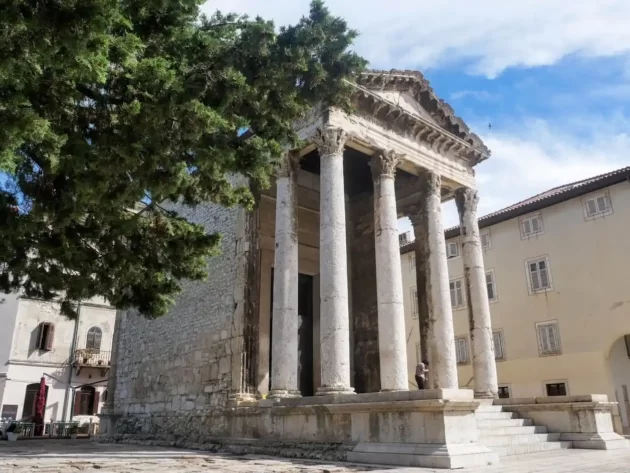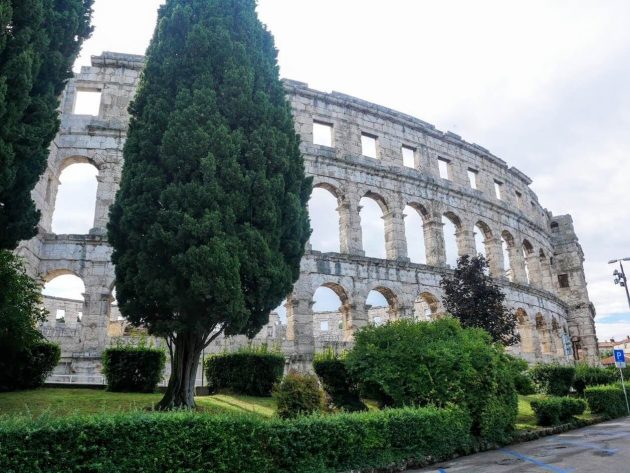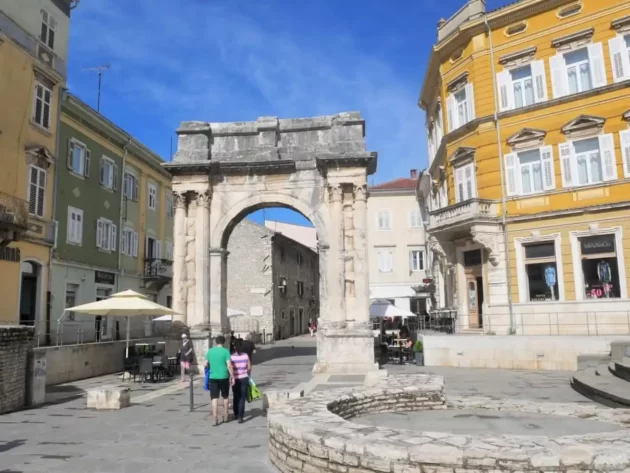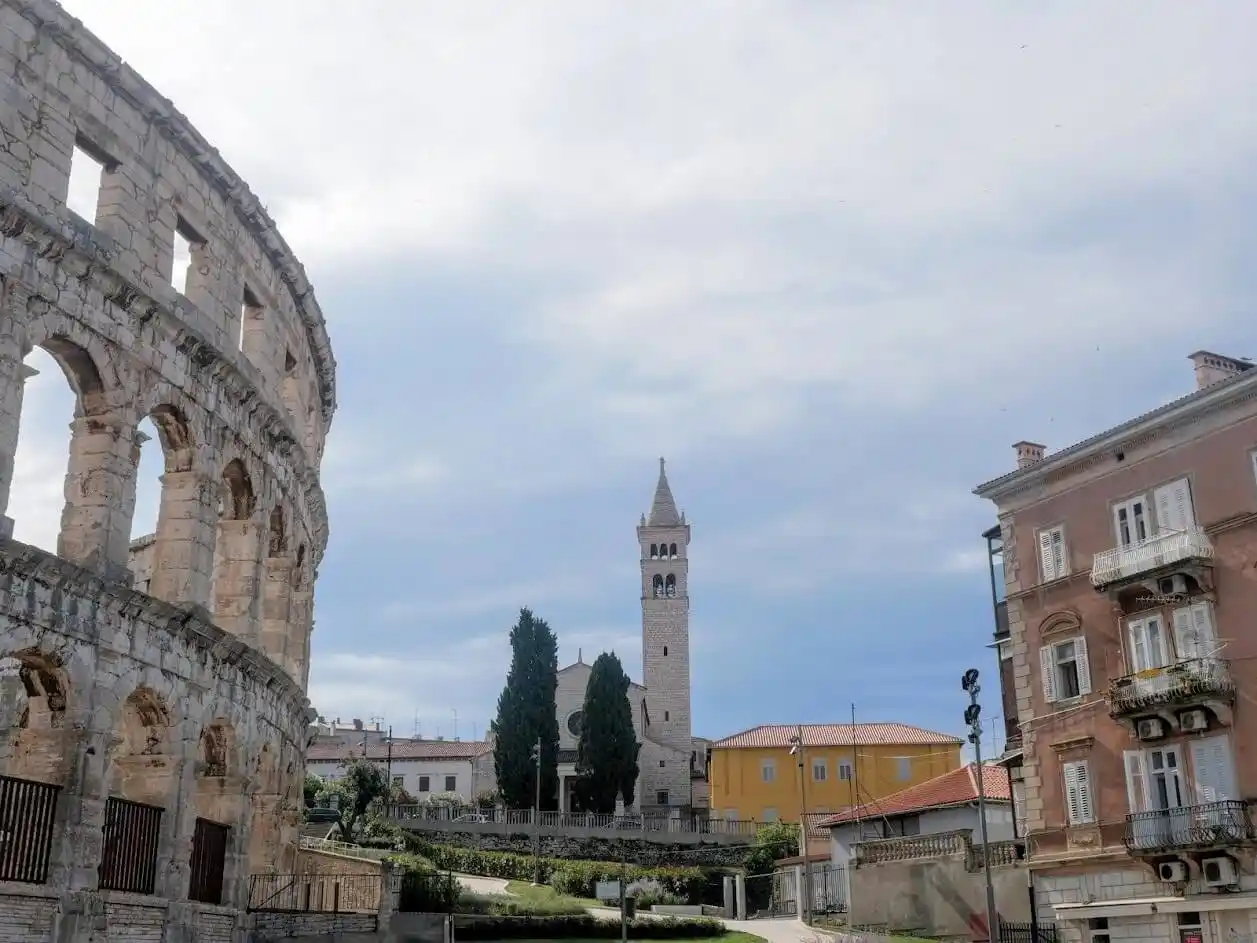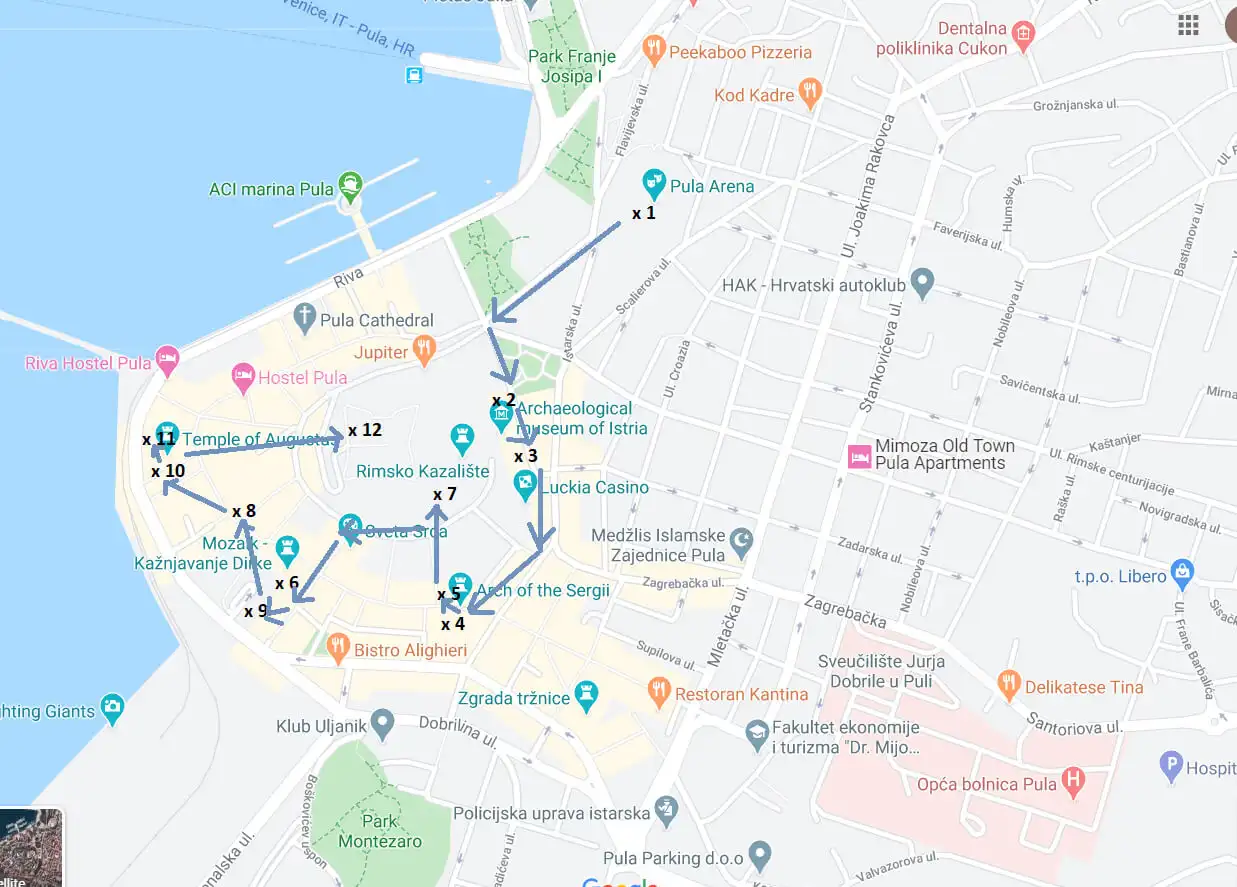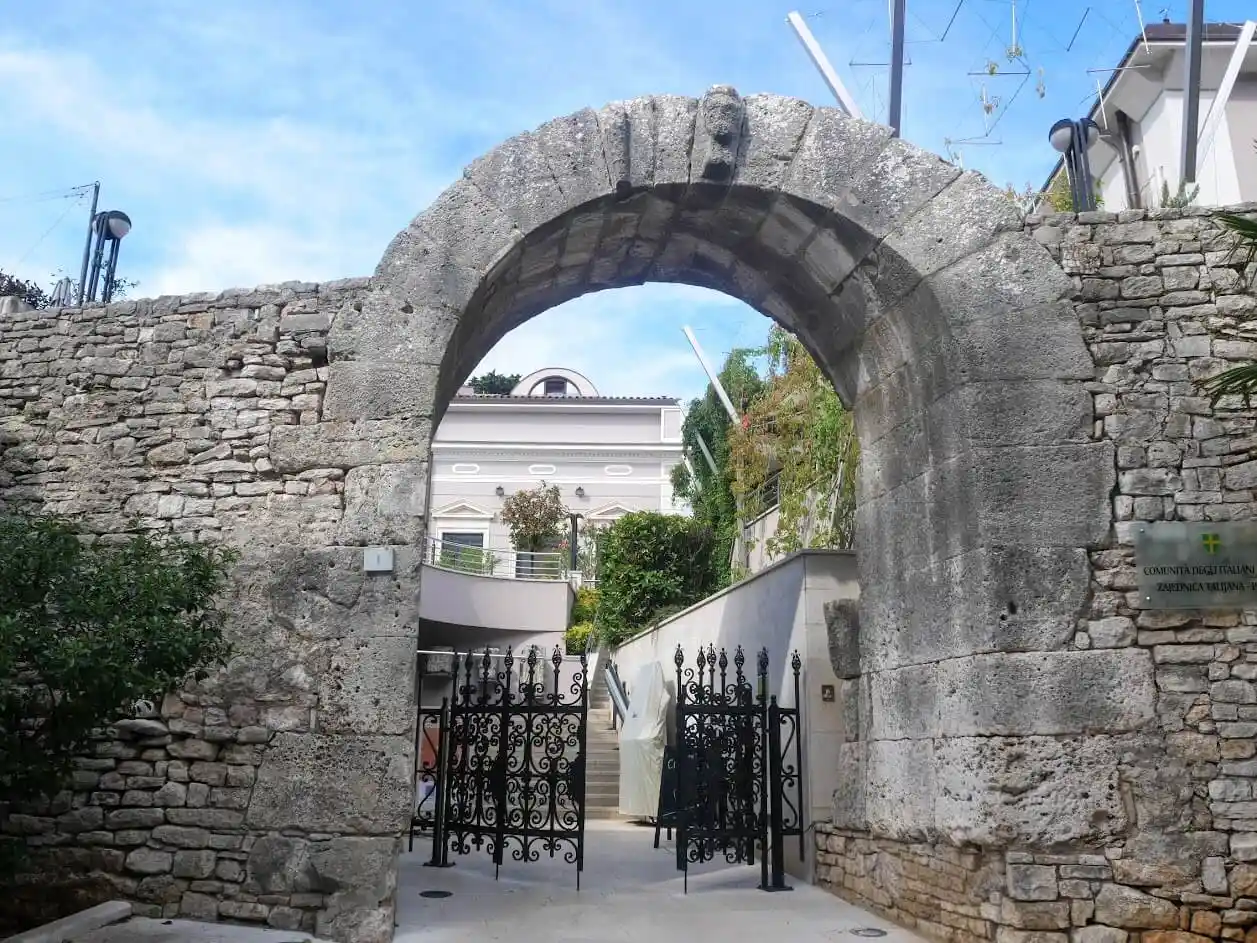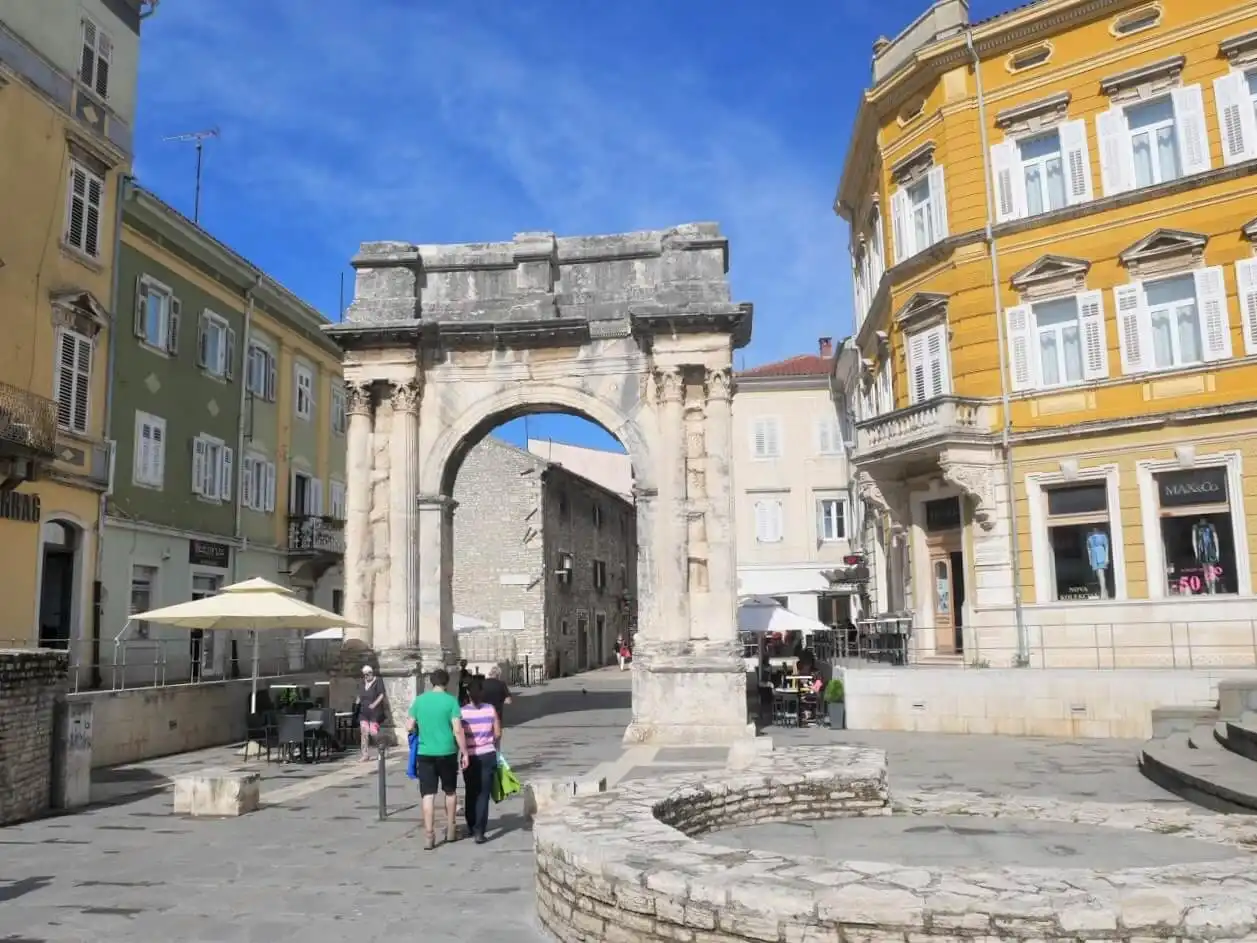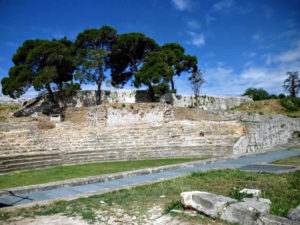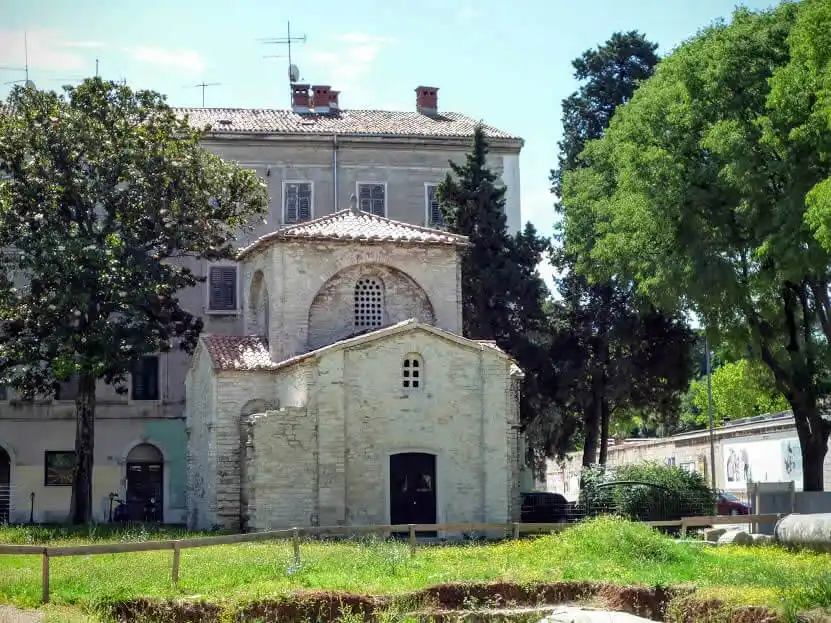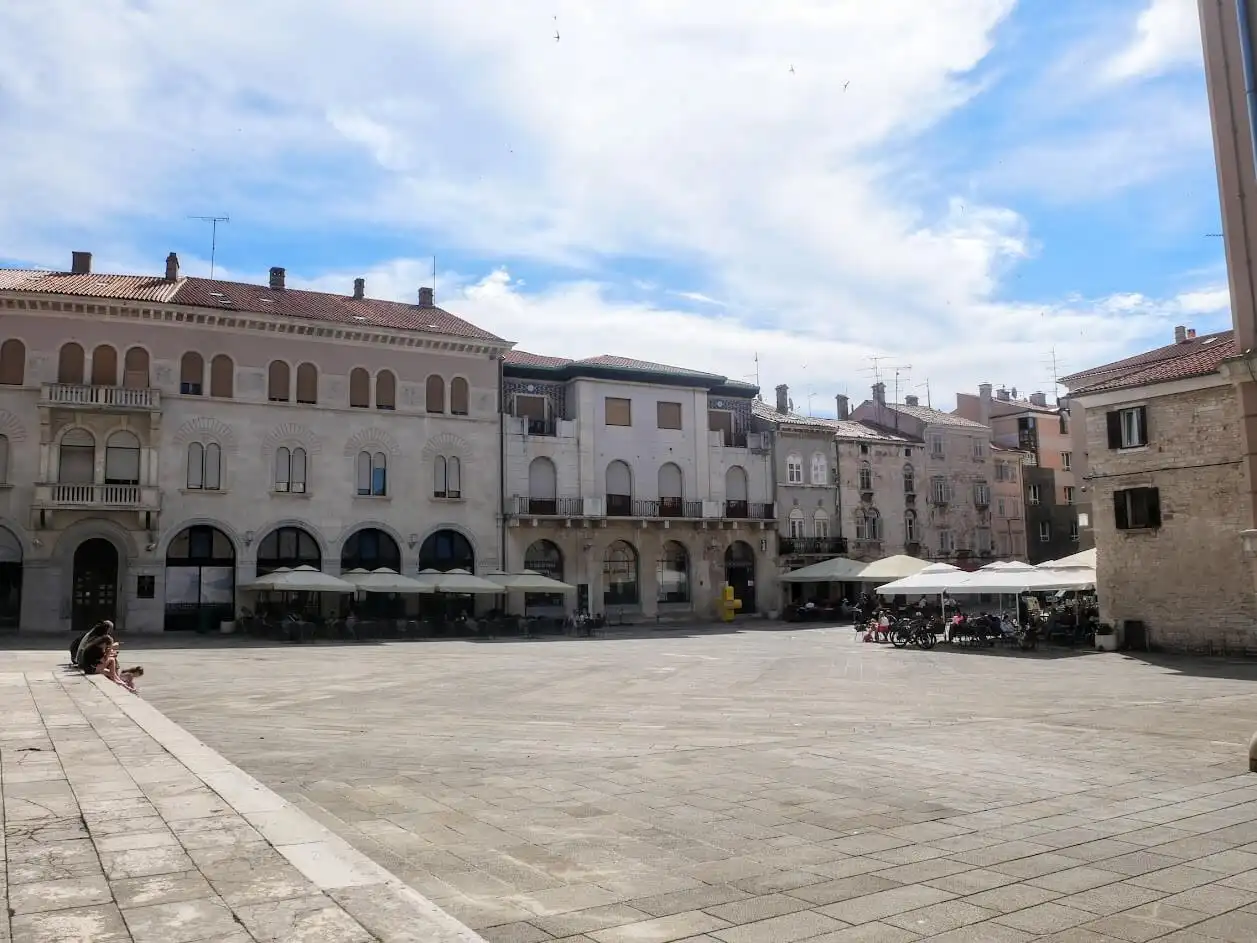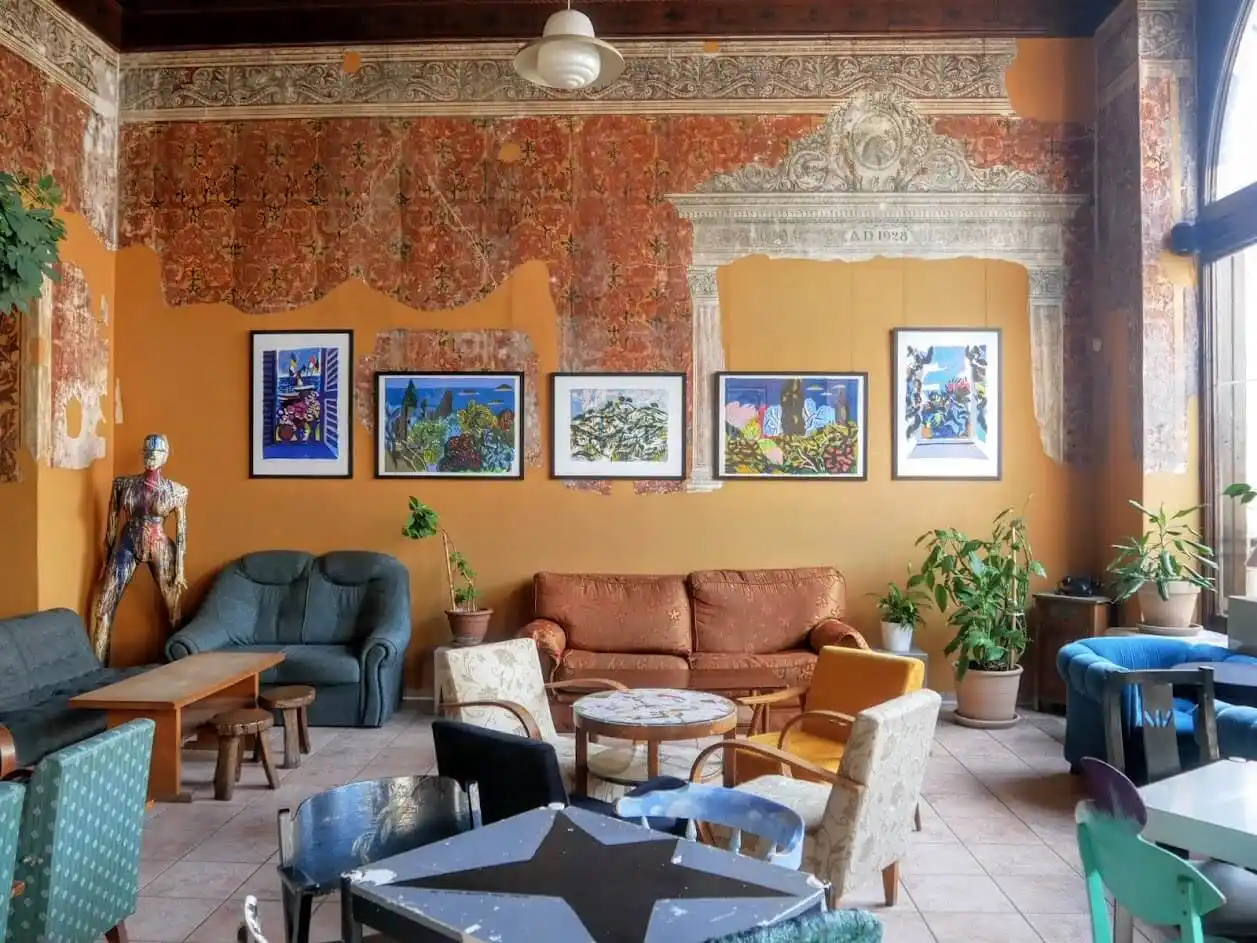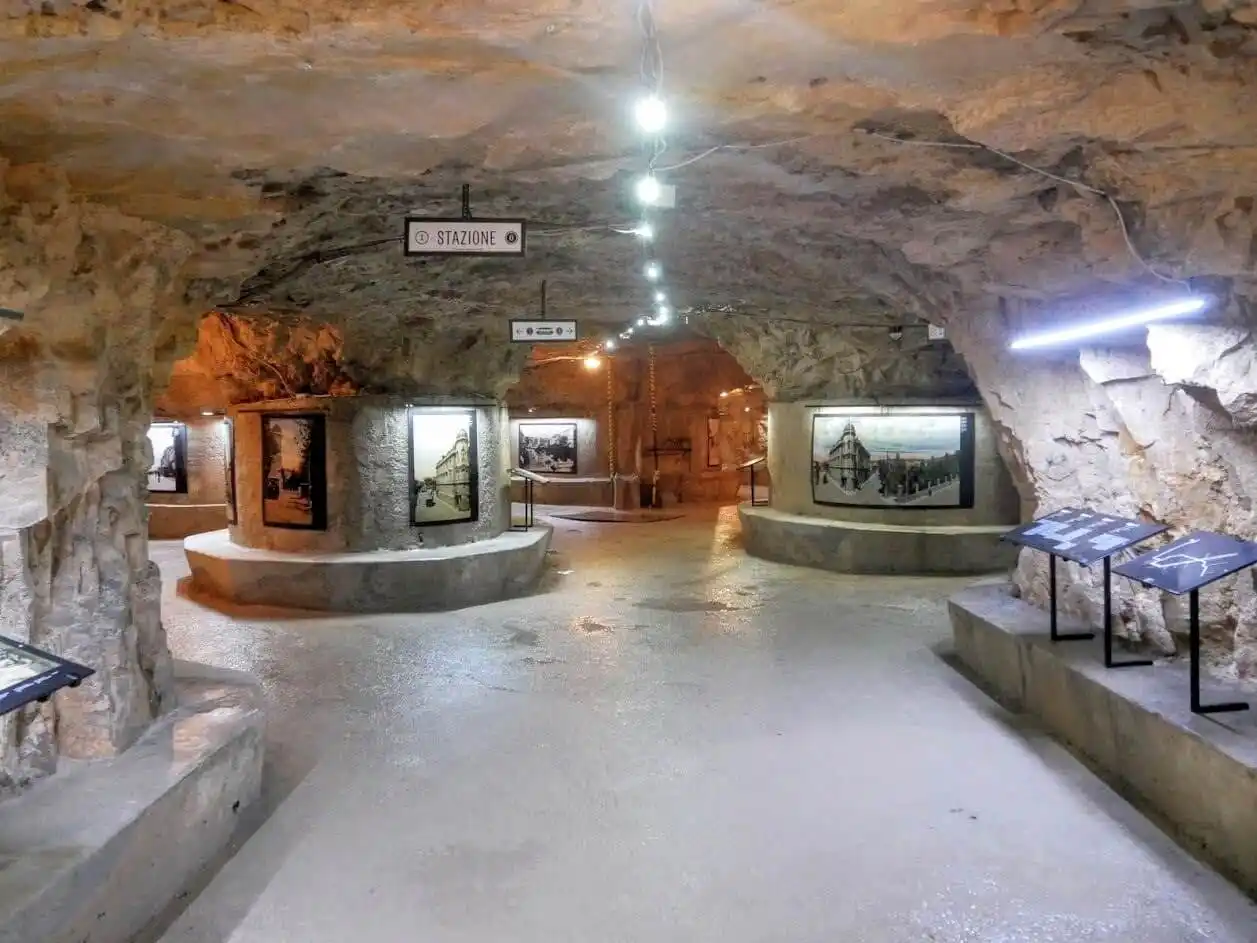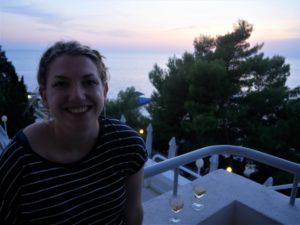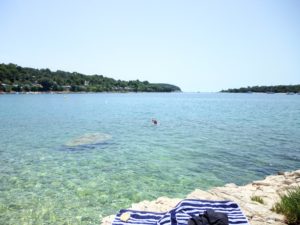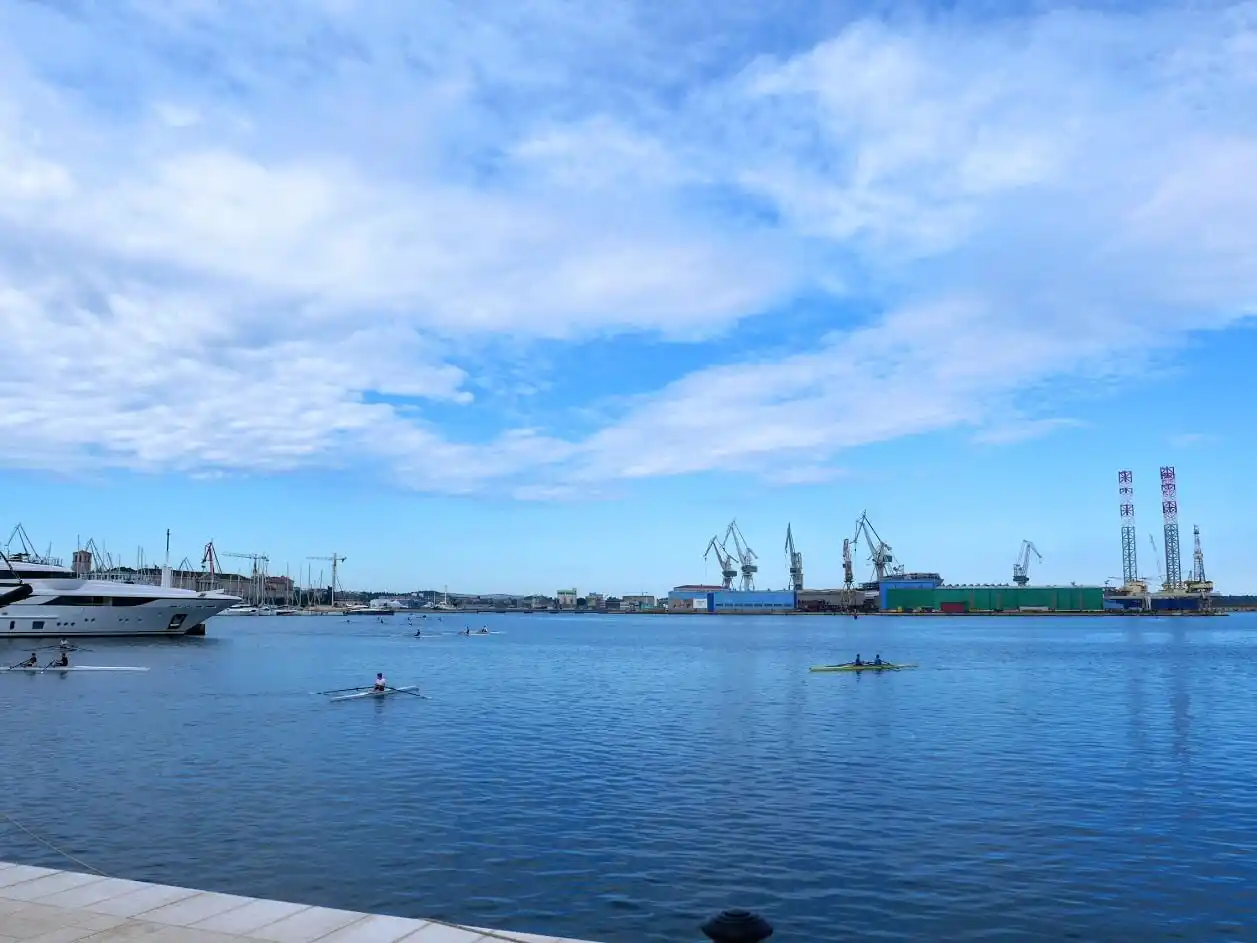The biggest Croatian peninsula, Istria, is filled with cute villages, small towns and charming places. And it’s always hard to choose which one to visit. But, if you’re interested in history and culture, then Pula should get on your list of places to visit while in Istria. After being in that town on numerous occasions, I thought it’s the right time to finally create a Pula guide with some of my recommendations on what to do and see in Pula in a day.
What to see in Pula on a day trip
I’ve spent all of my childhood holidays in Pula. And whenever in Istria, I try to go at least on a day trip to Pula. This lovely town has so many interesting sights, it could be hard to select what to see in Pula in a day. However, here is a guide with some of the best places in Pula, that will help you plan your visit.
Located at the very south of the Istrian peninsula, its city centre is filled with old buildings, cute shops and lovely restaurants. While walking through its narrow streets, you’ll stumble upon some beautiful Medieval and Renaissance palaces. So one of my top tips for your day trip to Pula is to look up while wandering around it.
⤷ Read more: Istria Travel Guide & the best places to visit in Istria
History of Pula
Let’s start with a short history of Pula first.
Although it was populated since the Prehistory, it’s vital time starts with Romans who colonised it during the 2nd century BC.
It soon became an important Roman port with many buildings still preserved from that time. All of them are definitely among the things to see in Pula during a day trip. Some of the most amazing sites from the Roman time you shouldn’t miss while in Pula are the Amphitheatre, the Temple of Augustus and the Triumphal Arch.
Pula changed many rulers throughout its history. Those different cultural influences could still be seen in city architecture today. It was a part of the Byzantine Empire between 540 and 751. Remains of Basilica of Saint Mary Formosa in the city centre are still witnessing about it.
Later on, it was ruled by the Frankish Empire, after which it became a part of the Republic of Venice. During that time it was visited by a famous poet Dante Alighieri, who even mentioned it in his Divine Comedy.
After a short French rule, at the beginning of the 19th century, Pula became a part of the Austrian Empire, as did the majority of Croatia. It was definitely a good time for Pula. It became the main port in the Empire and an important shipyard. The tradition of shipbuilding is still present in Pula, and you’ll see numerous cranes in its harbour.
The city of Pula was heavily bombed during the Second World War, and its city centre was severely damaged. One of the bombs fell directly to the Temple of Augustus. After it, Pula became a part of Yugoslavia, and then in 1991 of the Republic of Croatia.
⤷ Read more: What to do & visit in Croatia
What to see in Pula in a day
Pula is filled with so many exciting sights, it could be hard to decide on what to see in Pula in a day. However, here is a quick Pula guide with some of the most interesting places you should visit in Pula.
⤷ TIP: Here is a map with a history walking tour in the city centre. Marked on the map are the locations I’m mentioning in this blog post, too. Check out the names of the locations and their addresses below.
Amphitheatre
Address: Flavijevska ulica / Number on the map: 1
Known as Arena among the locals, this is one of the best-preserved Roman amphitheatres in the world. It was built and reconstructed for almost a hundred years, between 27 BC and 68 AD. Pula’s Amphitheatre was used for the gladiator combats until the 5th century when they were banned because of its cruelty by the emperor Honorius.
However, the Amphitheatre remained in use during the Middle Ages for the fairs and tournaments between the Knights of Malta. It’s still an essential part of the city. Today it’s used for the film festival, performances and music concerts. A few years ago it was even home to an ice hockey game.
During the Second World War, the Italian government had an idea of dismantling the Amphitheatre and transporting it to Italy. But luckily for Pula, that idea was soon abandoned because of its high cost.
Each year between June and September, an event called Spectacvla Antiqva is organised in Pula’s Amphitheatre. It recreates the gladiator’s fights, during which the actors are using authentic Roman clothes and the real weapon. You can watch a short YouTube video from it on a link here. Check out their Facebook page for the show dates.
⤷ TIP: There could be quite a long queue in front of the Amphitheatre in Pula. To avoid the crowds, be sure to buy your ticket online (here is the link).
Old city walls, The Gate of Hercules & the Twin Gates
Address: Carrarina and Giardini streets / Number on the map: Twin Gates – 2, The Gate of Hercules – 3
During the Roman time, Pula was surrounded by the strong city walls. In the later centuries, they were destroyed and rebuilt a few times. Today, you can see their remains alongside Carrarina and Giardini streets towards the Triumphal Arch.
Initially, there were ten city gates through which Pula could be entered. Next to the Triumphal Arch, two more old Roman entrance gates still remain as a part of Pula’s ancient city walls. They are located close to each other at Carrarina street.
The Gate of Hercules, the oldest monument in the city, was built during the 1st century. In the Roman time, Hercules was one of the symbolical protectors of the city of Pula. Hence the gate has a head of Hercules on its top.
The Twin Gates, as its name suggests, consists of two arches and dates from the 2nd century. Just behind them, the Archaeological Museum of Istria is located.
⤷ Read more: Best places to visit in Croatia
Triumphal Arch of the Sergii
Address: Flanaticka ulica 2 / Number on the map: 4
The third remaining city gate from the Roman time is a beautiful Triumphal Arch of the Sergii, also known as the Golden Gate. Sergii were a powerful local family. The triumphal arch was erected to celebrate the victory at Actium, between 29th and 27th BC.
Originally built just behind the city entrance, the gates and the walls were destroyed during the 19th century. Hence, the Triumphal Arch stands alone today.
James Joyce Statue
Address: Ulica Sergijevaca 67 / Number on the map: 5
Close to the Triumphal Arch, at a cafe terrace just next to it, you can see the statue of James Joyce. He’s depicted while sitting at a table and enjoying the view of the Roman ruins. So, you can actually sit at a table and have a coffee with a famous Irish writer.
The reason his statue is there is that he lived and worked in Pula between 1904 and 1905, teaching English at the Berlitz School.
⤷ Read more: Weekend in Istria at Al Fresco Mobile Homes
Roman sites in the centre of Pula
Address: Roman mosaic – Ulica Sergijevaca 18, Theatre – Herculov prolaz 1, Roman house – Ulica Sergijevaca 3 / Number on the map: Roman mosaic – 6, Theatre – 7, Roman house – 8
After the massive bombing during the Second World War, the majority of the city centre of Pula had to be repaired. While cleaning the fragments of destroyed buildings, citizens of Pula have found many Roman sites around their city. When walking around the city centre, look for the brown signs that will show you where to look for some of them.
- Roman mosaic – Located close to Saint Mary Formosa Church a fascinating Roman floor mosaic is located. It has a depiction of Dirke punishment. The mosaic is quite big and created probably in the 2nd or 3rd century.
- Roman Theatre – During the Roman time, Pula had two theatres. However, only the smaller one could still be seen today. Visitors were approaching it through the Twin Gates. It’s still quite well preserved, and it’s located next to the Pula’s castle.
- Agrippina’s House – In one of the side alleys just behind the Roman Forum in Pula, you can see an archaeological site with the remains of the Roman Agrippina’s House.
Saint Mary Formosa Church
Address: Maksimilijanova ulica / Number on the map: 9
Pula was a part of the Byzantine Empire for almost two centuries and this small church located in its city centre witnesses about that. Built in the 6th century, it was a significant early Christian basilica.
However, today, you can only see its archaeological remains and a small chapel in the form of the Greek cross. It’s decorated with mosaics that resembles some churches built at the same time in Ravenna (Italy). Sadly, during the Venetian rule, some of the statues and decoration were taken to Venice, and can today be seen in churches there (for example in Saint Mark’s Church).
⤷ Read more: Rovinj Travel Guide
Roman Forum
Address: Forum / Number on the map: 10
The old Roman Forum in Pula was constructed in the 1st century BC. It was the main square in the city back then, and it still is today. There were a few temples on it, such as the temples of Jupiter, Juno and Minerva. However, the only one still remaining today is the Temple of Augustus.
The Medieval Communal Palace located just next to the Temple of Augustus has the remains of those Roman temples incorporated in its architecture. It’s the seat of the city government still today.
⤷ TIP: One of my favourite cafes in Pula is located at the Forum. It’s called Kunstcafe Cvajner, and although it has a lovely terrace overlooking the Temple of Augustus, be sure to get inside and check out its beautiful interior and small exhibitions organised there.
The Temple of Augustus
Address: Forum / Number on the map: 11
The only remaining temple on the Roman Forum today is the Temple of Augustus. It was built at the beginning of the 1st century. Used as a church and wheat storage during the Middle Ages, it became a gallery of the Roman statues at the beginning of the 19th century.
During the Second World War, it was directly hit by a bomb and badly damaged. But, you can hardly notice that today, since it was carefully restored afterwards.
Pula Castle (Kaštel)
Address: Gradski uspon 10 / Number on the map: 12
The star-shaped castle with four bastions on the hill at the centre of Pula was built by Venetians during the 17th century. However, the archaeologists think there was some kind of a fort there since the Prehistory. The Historical Museum of Istria is located in it today. Besides an interesting exhibition it’s home to, it offers one of the best views on Pula.
⤷ Read more: Are you staying longer in Pula? Go on a day trip to Brijuni Islands.
Museum of Olive Oil
Address: Ulica svetog Teodora 1a
Istria is well known for its olive oil, and you can learn a lot about it in Pula’s Museum of Olive Oil. You can try different sorts of olive oils, learn about the history of its production in Istria, and even buy some to get home with you. I’m sure there couldn’t be a better souvenir to take back with you from Pula.
⤷ TIP: Here is the link to an online ticket with some olive oil tasting included.
Zerostrasse
Address: Carrarina ulica 3
The net of underground tunnels below Pula spreads almost around the entire city. It was built during the First World War as a shelter for its citizens. Tunnels were recently open to the public and became an exciting place to visit in Pula. It’s especially nice to visit them during the hot summer days because it’s so lovely and fresh inside the tunnels.
⤷ TIP: If looking for a great restaurant in the city centre of Pula, check out Piazza Nove located just behind the Temple of Augustus. It has a lovely terrace, great stuff and fantastic food. I strongly recommend it!
Outside the Pula city centre
If you’d like to explore Pula outside its city centre and even go for some swimming, then these are the places I recommend.
Verudela
Address: Verudela
Verudela is a small peninsula at the south of Pula. Covered with pine forest and home to a few hotels, it has some lovely beaches where you can enjoy the sea and sun. There are a few restaurants and cafes there, too. You can reach it by car (there is plenty of parking space there) or with public transport.
Have a drink at Bunarina
Address: Verudela 9
Would you like to feel like a local in Pula? Visit a small port called Bunarina, located just next to Verudela then. This is a place where many locals from Pula have their yachts or are catching a boat to some smaller islands, such as Fratarski Island.
⤷ TIP: If you’d really like to feel like a local, try a drink called pašareta. That red drink is produced in a local small soda factory. And as far as I know, only sold in Istria.
Some extra tips for visiting Pula
Where to park in Pula – Whenever in Pula we usually park in Pula’s port. It’s very close to Amphitheatre and the city centre, and the parking rate is a bit lower than closer to the old city centre. Although, still everything is within walking distance from there.
Pula’s market – I love Pula’s market! If you’d like to buy some local fruit and vegetables, or fresh fish, be sure to pay a visit to Pula’s market.
Pula souvenirs – What to get as a souvenir from Pula? Around the Amphitheatre, you’ll find a few stands selling stone models of some famous sights in Pula. If that’s not your thing, a small bag of lavender, delicate olive oil or Malvasia wine could be a great choice.
Pula is a small town with a great history. And if you’re spending your holidays in Istria, be sure to visit it. I hope that this quick guide to Pula with some tips on what to see in Pula in a day trip will help you in planning your visit to this fantastic town, both Dante and James Joyce visited, as well.
*This post contains some affiliate links.


